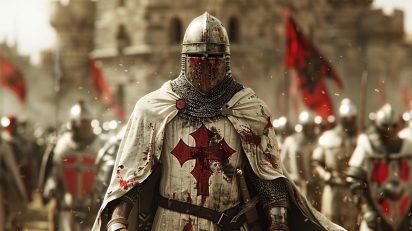Introduction
The Knights Templar, a medieval Christian military order, amassed great wealth and power before their sudden fall in the early 14th century. Accused of heresy and corruption, many members were arrested and executed, but some believe the order survived in secret. The fate of their vast treasures remains a subject of speculation. This article delves into the history, rise, fall, and enduring mysteries of the Knights Templar.
Historical Background
Formed around 1119 by Hugh de Payens and a group of knights, the Knights Templar was established to protect Christian pilgrims traveling to the Holy Land. Recognized by the Church in 1129, the order rapidly gained prominence due to their military prowess and dedication.
Structure and Organization
The Templar organization was hierarchical, with the Grand Master at the top. Other key roles included the Marshal, responsible for military operations, and the Draper, in charge of clothing and equipment. This structure allowed the Templars to operate efficiently across different regions.
Wealth and Influence
The Templars’ wealth came from various sources, including donations from European nobility, land ownership, and banking activities. They established a network of fortifications and preceptories, which served as both military bases and financial centers. Their influence extended into political and economic spheres, making them a powerful entity in medieval Europe.
Military Achievements
The Knights Templar played a crucial role in the Crusades, providing military support to Christian forces. They participated in major battles, such as the Siege of Acre and the Battle of Hattin, demonstrating their strategic importance in these campaigns.
The Fall of the Knights Templar
In the early 14th century, the Templars faced accusations of heresy, corruption, and other charges. On October 13, 1307, King Philip IV of France ordered the arrest of Templar members, marking the beginning of the end for the order.
The Role of King Philip IV
King Philip IV, heavily indebted to the Templars, saw an opportunity to eliminate his debt and seize their wealth. He pressured Pope Clement V to take action against the Templars, leading to their persecution.
The Trials and Executions
Templar members were subjected to brutal interrogation methods to extract confessions. Many were tried and executed, including Grand Master Jacques de Molay, who was burned at the stake in 1314. These trials tarnished the order’s reputation and led to its official dissolution.
Dissolution of the Order
In 1312, Pope Clement V issued the papal bull Vox in excelso, formally disbanding the Knights Templar. Their assets were redistributed, primarily to the Knights Hospitaller, and the order ceased to exist officially.
Survival Theories
Despite their official disbandment, some theories suggest that the Templars survived in secret. These claims include the possibility of Templar members integrating into other orders or continuing their activities covertly. However, concrete evidence for these theories is lacking.
Legacy and Impact
The Knights Templar left a lasting legacy, influencing subsequent military and religious organizations. Their disciplined structure and wealth management practices were adopted by other orders, and their stories became embedded in European folklore.
The Mystery of the Templar Treasure
Legends persist about the vast treasure of the Templars, rumored to be hidden away. Numerous searches and excavations have been conducted, but definitive evidence of this treasure remains elusive.
Templar Symbols and Architecture
The Templars are known for their distinctive symbols, such as the red cross, and their architectural contributions, including fortified castles and preceptories. These symbols and structures have become iconic representations of the order.
Cultural Representations
The Knights Templar have been depicted in various forms of literature and media, from medieval chronicles to modern films and novels. These representations often blend historical facts with myths, enhancing their enigmatic image.
Archaeological Discoveries
Archaeological efforts have uncovered significant Templar sites and artifacts, providing insights into their daily life and operations. Findings include manuscripts, weapons, and remnants of their fortifications.
Technological Advancements in Research
Modern technology, such as ground-penetrating radar and 3D modeling, has revolutionized the study of Templar sites. These tools help archaeologists uncover hidden structures and understand the order’s activities better.
Mysteries and Unanswered Questions
Many aspects of the Knights Templar remain unresolved, such as the true extent of their wealth and the exact reasons for their persecution. Ongoing research aims to shed light on these mysteries.
Impact on Historical Understanding
The Knights Templar challenge existing theories about medieval history and the relationship between church and state. Their rise and fall illustrate the complexities of power dynamics during this period.
Preservation Efforts
Preserving Templar artifacts and sites presents significant challenges due to environmental and human factors. Efforts include conservation projects and legal protections to safeguard these historical treasures.
Visitor Experience
Visitors can explore Templar sites and museums worldwide, offering a glimpse into the order’s history and legacy. These sites provide educational experiences and a connection to medieval history.
Conclusion
The Knights Templar’s rise, fall, and enduring mystery continue to captivate historians and enthusiasts alike. Their contributions to medieval society and the unanswered questions surrounding their fate ensure that the Templars remain a fascinating subject of study.
FAQs
Who were the Knights Templar?
The Knights Templar were a medieval Christian military order founded in the early 12th century to protect pilgrims traveling to the Holy Land.
Why were the Knights Templar disbanded?
The Knights Templar were disbanded due to accusations of heresy, corruption, and other charges, influenced by King Philip IV’s desire to seize their wealth.
What happened to the Templar treasure?
The fate of the Templar treasure remains a mystery, with various legends and theories suggesting it was hidden away or lost.
Are there any modern descendants of the Templars?
There are organizations today that claim lineage or inspiration from the Knights Templar, but the original order was officially disbanded in the early 14th century.
Can the public visit Templar sites?
Yes, many Templar sites and museums are open to the public, offering insights into their history and legacy.

